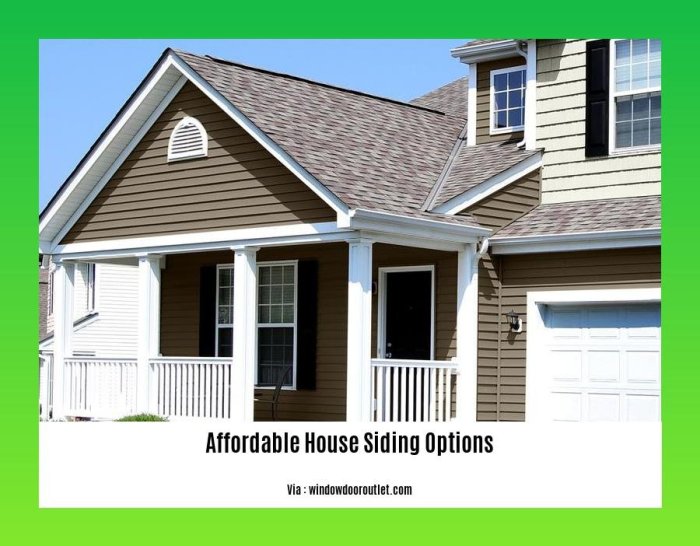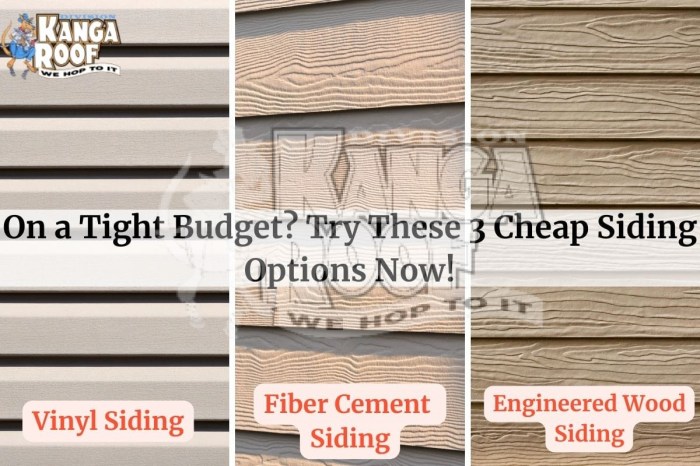Exploring Affordable Home Siding Options

Diving into the realm of affordable home siding options, this introduction sets the stage for an insightful exploration into different materials, installation tips, and energy efficiency considerations. Stay tuned for a comprehensive guide that will help you make informed decisions for your home.
In the following paragraphs, we will delve into the various types of affordable siding materials, cost-effective options, DIY installation tips, and the importance of energy efficiency in relation to siding choices.
Types of Affordable Home Siding Options
When it comes to choosing affordable home siding options, there are several materials to consider. Each type of siding has its own set of pros and cons, as well as varying levels of durability and maintenance requirements.
Vinyl Siding
Vinyl siding is a popular choice for homeowners looking for an affordable option. It is low-cost, easy to install, and comes in a variety of colors and styles. However, vinyl siding may not be as durable as other materials and can crack or fade over time.
Fiber Cement Siding
Fiber cement siding is another affordable option that is known for its durability and low maintenance requirements. It is resistant to rot, fire, and insects, making it a long-lasting choice for homeowners. However, fiber cement siding can be more expensive upfront compared to vinyl siding.
Wood Siding
Wood siding is a classic choice that adds a natural and rustic look to a home. While wood siding can be affordable, it requires regular maintenance to prevent rot, pests, and weather damage. Additionally, wood siding may need to be repainted or stained periodically.
Engineered Wood Siding
Engineered wood siding offers the look of real wood at a more affordable price point. It is designed to be more durable and resistant to moisture, rot, and pests compared to traditional wood siding. However, engineered wood siding may still require some maintenance over time.
Metal Siding
Metal siding, such as aluminum or steel, is a cost-effective option that is known for its durability and low maintenance. It can withstand harsh weather conditions and is resistant to fire, rot, and pests. However, metal siding may dent or scratch easily.
Cost-Effective Siding Materials

When considering affordable home siding options, it is essential to explore cost-effective siding materials that not only fit your budget initially but also have low long-term maintenance costs. The quality of the siding material plays a crucial role in determining its affordability over time.
Vinyl Siding
Vinyl siding is one of the most cost-effective options available in the market. It has a relatively low initial cost compared to other materials such as wood or fiber cement. Additionally, vinyl siding requires minimal maintenance, reducing long-term upkeep costs.
Its durability and resistance to elements make it a practical and affordable choice for many homeowners.
Fiber Cement Siding
Fiber cement siding is another cost-effective option known for its durability and low maintenance requirements. While the initial cost of fiber cement siding may be higher than vinyl, it offers long-term savings due to its longevity and resistance to rot, pests, and fire.
Investing in fiber cement siding can result in lower maintenance costs over the years.
Engineered Wood Siding
Engineered wood siding provides a balance between affordability and aesthetics. It offers the look of natural wood without the high price tag. While the initial cost of engineered wood siding may be higher than vinyl, it is still a cost-effective option compared to traditional wood siding.
With proper maintenance, engineered wood siding can last for many years, making it a practical choice for budget-conscious homeowners.
DIY Siding Installation Tips
When it comes to installing siding on your home, taking the DIY approach can save you a significant amount of money. However, it's important to be well-prepared and informed before starting the project. Here are some tips to help you achieve a professional finish on a budget.
Step-by-Step Guide for DIY Siding Installation
- Start by carefully measuring the area where the siding will be installed to ensure you purchase the right amount of materials.
- Remove any existing siding and repair any damaged areas on the exterior of your home before installing the new siding.
- Follow the manufacturer's instructions for installing the specific type of siding you have chosen, making sure to use the correct tools and techniques.
- Secure the siding properly to prevent it from coming loose during storms or high winds.
Common Mistakes to Avoid During a DIY Siding Project
- Avoid neglecting proper preparation, such as not cleaning or repairing the surface before installing the new siding.
- Don't rush the installation process, as this can lead to mistakes that may be costly to fix later on.
- Avoid using the wrong type of fasteners or tools, as this can compromise the integrity of the siding.
- Ensure proper ventilation behind the siding to prevent moisture buildup and potential damage to your home.
Tips for Ensuring a Professional Finish on a Budget
- Consider painting or staining the siding yourself to save on professional painting costs.
- Take your time and pay attention to detail to ensure a clean and polished look once the siding is installed.
- Utilize online tutorials and resources to learn more about best practices for siding installation and maintenance.
- Invest in quality materials that are durable and long-lasting to avoid having to replace the siding prematurely.
Energy Efficiency and Insulation
When it comes to affordable home siding options, considering energy efficiency and insulation is crucial for long-term cost savings and comfort.
Energy Efficiency of Siding Materials
Different siding materials can impact the energy efficiency of a home. For example, vinyl siding is known for its insulating properties, helping to regulate indoor temperatures and reduce energy costs.
Importance of Insulation
- Insulation plays a key role in maintaining a comfortable indoor environment by preventing heat loss in the winter and heat gain in the summer.
- Proper insulation can reduce the strain on heating and cooling systems, leading to lower energy bills over time.
- When choosing affordable siding options, consider the insulation properties of the material to maximize energy efficiency.
Choosing Energy-Efficient Siding Materials
- Look for siding materials with high R-values, indicating better insulation capabilities.
- Consider insulated vinyl siding or fiber cement siding for improved energy efficiency.
- Opt for light-colored siding to reflect sunlight and reduce heat absorption, keeping your home cooler in hot weather.
- Consult with a professional to assess your home's insulation needs and choose the most energy-efficient siding material within your budget.
Final Wrap-Up

As we wrap up our discussion on affordable home siding options, remember that making the right choice not only enhances the aesthetics of your home but also contributes to its long-term durability and energy efficiency. Whether you opt for vinyl, wood, or fiber cement, your decision can have a lasting impact on your home's exterior.
Top FAQs
What are the most common types of affordable home siding materials?
Common types include vinyl, wood, fiber cement, and aluminum siding.
How do initial costs differ from long-term maintenance costs for siding materials?
While vinyl may have a lower initial cost, wood siding may require more maintenance over time, impacting long-term expenses.
What are some common mistakes to avoid during a DIY siding installation?
Avoid improper measuring, inadequate surface preparation, and neglecting weather conditions during installation.
How do different siding materials impact the energy efficiency of a home?
Materials like insulated vinyl or fiber cement can enhance energy efficiency by providing better insulation properties.
Why is insulation important when considering affordable siding options?
Proper insulation can help reduce energy costs and improve the overall comfort of your home, making it a crucial factor in affordability.

